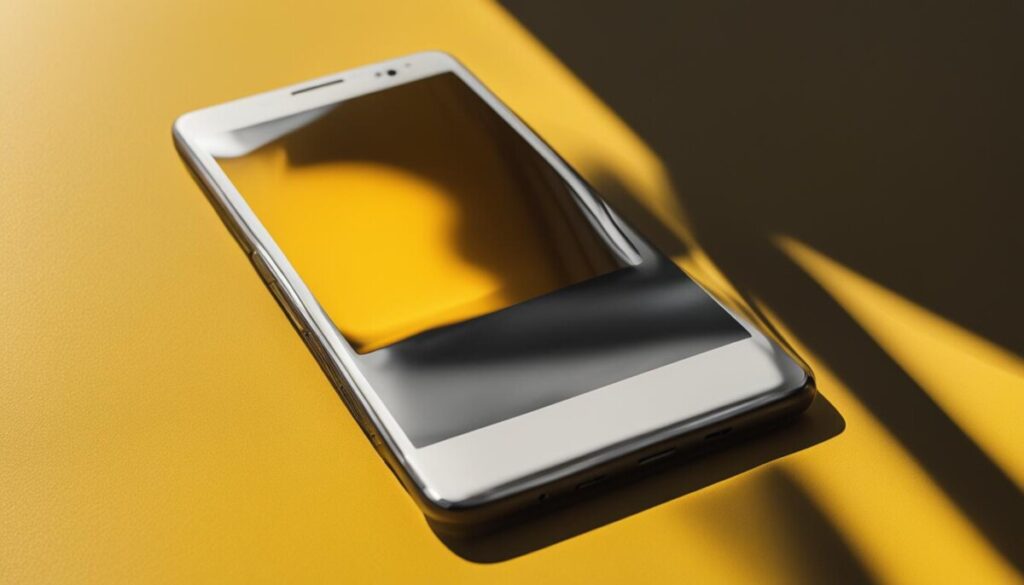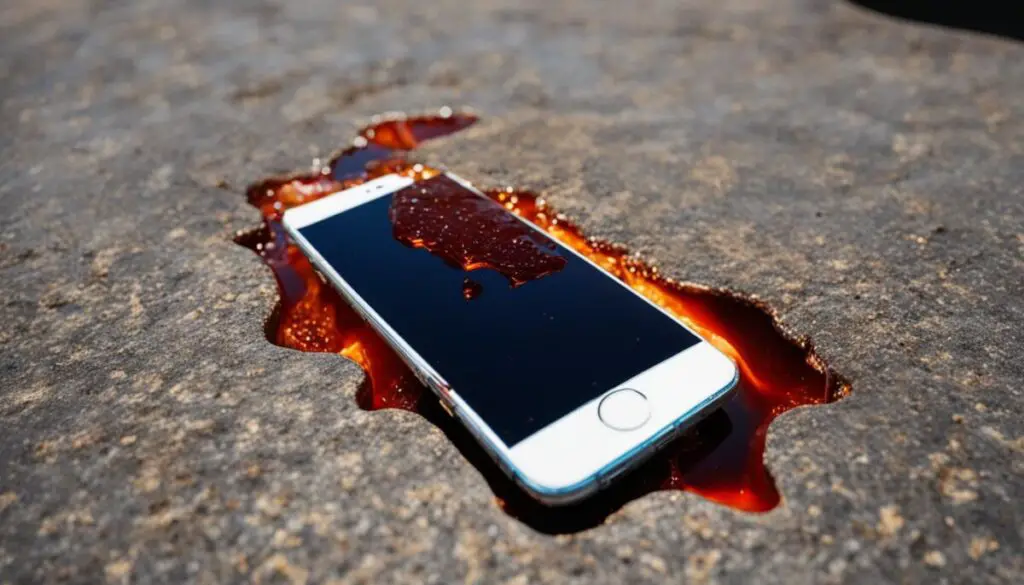Have you ever wondered why your phone suddenly becomes hot to the touch? Whether it’s during a phone call, using a power-intensive app, or simply sitting idle, phone overheating can be a concerning issue. In this article, we will explore the various causes of phone overheating and provide insights into how you can prevent it from happening.
Phones can get hot for several reasons. Overuse, a strained battery, direct heat exposure, an overloaded CPU, outdated software, and even malware infections can all contribute to your phone heating up. Factors such as direct sunlight, too many open apps, power-intensive apps, faulty battery or charger cable, wireless charging, gaming for too long, streaming video content, and software updates can also contribute to phone overheating. It’s important to identify the specific cause to effectively address the issue.
Key Takeaways:
- Phone overheating can be caused by various factors, including overuse, direct heat exposure, and outdated software.
- Factors such as direct sunlight, too many open apps, power-intensive apps, and faulty hardware can contribute to phone overheating.
- Gaming for extended periods and streaming video content can strain the CPU and lead to excessive heat generation.
- Software updates and malware infections can also cause temporary or prolonged phone overheating.
- To prevent phone overheating, avoid direct heat exposure, manage app usage, update software regularly, and protect your phone from malware.
Common Causes of Phone Overheating
Phone overheating can be a frustrating issue, but understanding the common causes can help you prevent it from happening. Let’s take a closer look at some of the main culprits behind phone overheating:
Overloading the CPU
Running too many apps or power-intensive apps simultaneously can put excessive strain on the phone’s CPU, causing it to heat up. When the CPU is overloaded, it works harder and generates more heat, resulting in an overheating phone.
Too Many Open Apps
Having too many apps running in the background can also contribute to increased phone temperatures. Each app consumes resources, including CPU power, even when you’re not actively using them. This continuous usage of resources can lead to heat buildup and subsequent overheating.
Power-Intensive Apps
Some apps, especially those with augmented reality features or heavy graphics loads, require significant processing power. When these power-intensive apps are in use, they can strain the CPU and cause the phone to heat up quickly.
To prevent phone overheating, it’s essential to manage your app usage effectively. Close unnecessary apps running in the background and avoid running too many power-intensive apps simultaneously. By minimizing the strain on the CPU, you can help maintain optimal phone temperature and prevent overheating.
Factors Contributing to Phone Overheating
Phone overheating can be attributed to various factors, including direct sunlight, faulty battery or charger cables, and wireless charging. Understanding these factors is crucial to effectively address and prevent phone overheating issues.
Direct sunlight poses a significant risk to phone overheating. Leaving your phone in direct sunlight for prolonged periods exposes it to intense heat, which can lead to internal component damage. It is important to avoid exposing your phone to direct sunlight and keep it in a shaded area whenever possible.
A faulty battery or charger cable can also contribute to excessive heat generation during charging. Using a damaged or incompatible battery or charger cable can cause increased resistance and heat buildup. It is advisable to use genuine and compatible charging accessories to prevent overheating issues.
Moreover, wireless charging can result in elevated phone temperatures due to energy leakage. Although convenient, wireless charging can lead to increased heat dissipation. Monitoring the phone’s temperature during wireless charging is essential to prevent overheating.
All these factors can be compounded by other contributing influences, such as direct sunlight exposure or background software updates. It is crucial to take necessary precautions to mitigate these factors and prevent phone overheating.

Properly managing the phone’s temperature is essential to ensure optimal performance and prevent overheating issues. In the next section, we will delve into activities that can contribute to phone overheating and how to mitigate them.
Activities That Can Cause Phone Overheating
To engage in gaming sessions or streaming video content for extended periods can strain the CPU and GPU, causing the phone to generate excessive heat. Both activities require intensive processing power from the phone, leading to elevated temperatures. Taking breaks during gaming sessions and limiting the duration of streaming video can help prevent phone overheating.
When participating in gaming sessions, whether it’s an intense battle or a prolonged gaming marathon, the phone’s CPU and GPU work hard to deliver a smooth and immersive gaming experience. This constant processing power utilization generates heat, which can raise the phone’s temperature. To prevent overheating, it is recommended to take regular breaks during gaming sessions. These breaks allow the phone to cool down and prevent the accumulation of excessive heat.
Similarly, when streaming video content, especially high-resolution videos or continuous streaming, the phone’s CPU works tirelessly to decode and render the video content. This continuous processing can lead to elevated temperatures, potentially causing the phone to overheat. Limiting the duration of streaming video sessions and giving the phone short breaks between episodes or movies can help manage the heat buildup and maintain optimal performance.
By being mindful of the time spent gaming and streaming video content, users can prevent excessive heat generation and avoid potential phone overheating issues. Taking occasional breaks during gaming sessions and limiting the duration of streaming sessions can help maintain the phone’s temperature within a safe range, ensuring a smooth and uninterrupted experience.
Other Factors Leading to Phone Overheating
In addition to the common causes discussed earlier, there are other factors that can contribute to phone overheating. These factors include software updates, malware or virus infections, and phone temperature.
Phone overheating can occur during or after software updates. When you update your phone’s software, temporary power usage increases as it fixes bugs or installs new features. This increased power usage can lead to elevated temperatures and, in some cases, overheating. Therefore, it’s important to monitor your phone’s temperature during and after software updates.
Another factor that can cause phone overheating is malware or virus infections. Malware or viruses can hijack your phone’s resources, including the CPU, and strain it to generate excessive heat. Mining malware, which uses your device’s processing power to mine cryptocurrencies, is particularly notorious for causing overheating issues. To prevent this, regularly scan and clean your phone for malware to ensure optimal performance and prevent overheating.
Lastly, maintaining the phone within the optimal temperature range is crucial to prevent overheating. The ideal operating temperature for most phones is between 32°F to 95°F (0°C to 35°C). Operating the phone outside of this temperature range can lead to performance issues and increase the risk of overheating.

Keeping these factors in mind and addressing them can help prevent phone overheating. Regularly update your phone’s software, use reputable security software to protect against malware, and be mindful of the phone’s temperature. By taking these measures, you can ensure that your phone operates smoothly without the risk of overheating.
Conclusion
Phone overheating is a common issue that can be caused by various factors, including direct heat exposure, overuse, faulty hardware, and malware infections. To prevent your phone from overheating and ensure optimal performance, there are several steps you can take.
Firstly, it’s important to avoid leaving your phone in direct sunlight for extended periods as this can lead to overheating. Additionally, managing app usage and closing unnecessary apps running in the background can help prevent excessive heat generation. Updating your phone’s software regularly is also crucial to address any potential bugs or issues that could contribute to overheating.
Furthermore, protecting your phone from malware infections is essential. Regularly scanning your device for malware and viruses can help prevent resource hijacking and excessive heat generation. To cool down your phone, consider removing unnecessary apps that may be consuming excessive resources, using a proper charging cable and adapter to avoid heat generation during charging, and employing cooling methods such as turning on airplane mode or using a fan.
By following these preventive measures, you can maintain an optimal phone temperature, ensure uninterrupted performance, and extend the longevity of your device without encountering the inconvenience of excessive heat. Keep your phone cool and enjoy its full potential!
FAQ
Why did my phone get so hot?
Phones can get hot for various reasons, including overuse, a strained battery, direct heat exposure, an overloaded CPU, outdated software, and malware infections. It’s important to identify the specific cause to address the issue effectively.
What are the common causes of phone overheating?
Overloading the CPU by running too many apps or power-intensive apps can cause the phone to heat up. Similarly, having too many open apps running in the background can contribute to increased phone temperatures. Apps with augmented reality elements or heavy graphics loads can also strain the CPU and lead to overheating.
What factors can contribute to phone overheating?
Leaving the phone in direct sunlight for a prolonged period can lead to overheating and potential damage to internal components. Using a faulty battery or charger cable can also cause excessive heat generation during charging. Additionally, wireless charging can make the phone warmer than usual due to energy leakage.
Which activities can cause phone overheating?
Engaging in gaming sessions or streaming video content for extended periods can strain the CPU and GPU, causing the phone to generate excessive heat. Taking breaks during gaming sessions and limiting the duration of streaming video can help prevent phone overheating.
What are other factors that can lead to phone overheating?
Phone overheating can occur during or after software updates as temporary power usage increases to fix bugs or install updates. Malware or virus infections can also lead to overheating as they hijack the phone’s resources. It’s also important to keep the phone within the optimal temperature range, which is typically between 32°F to 95°F (0°C to 35°C).
How can I prevent phone overheating?
To prevent phone overheating, avoid leaving the phone in direct sunlight, manage app usage, update software regularly, and protect the phone from malware. Additionally, removing unnecessary apps, using a proper charging cable and adapter, and cooling down the phone by turning on airplane mode or using a fan can help maintain optimal phone temperature.
